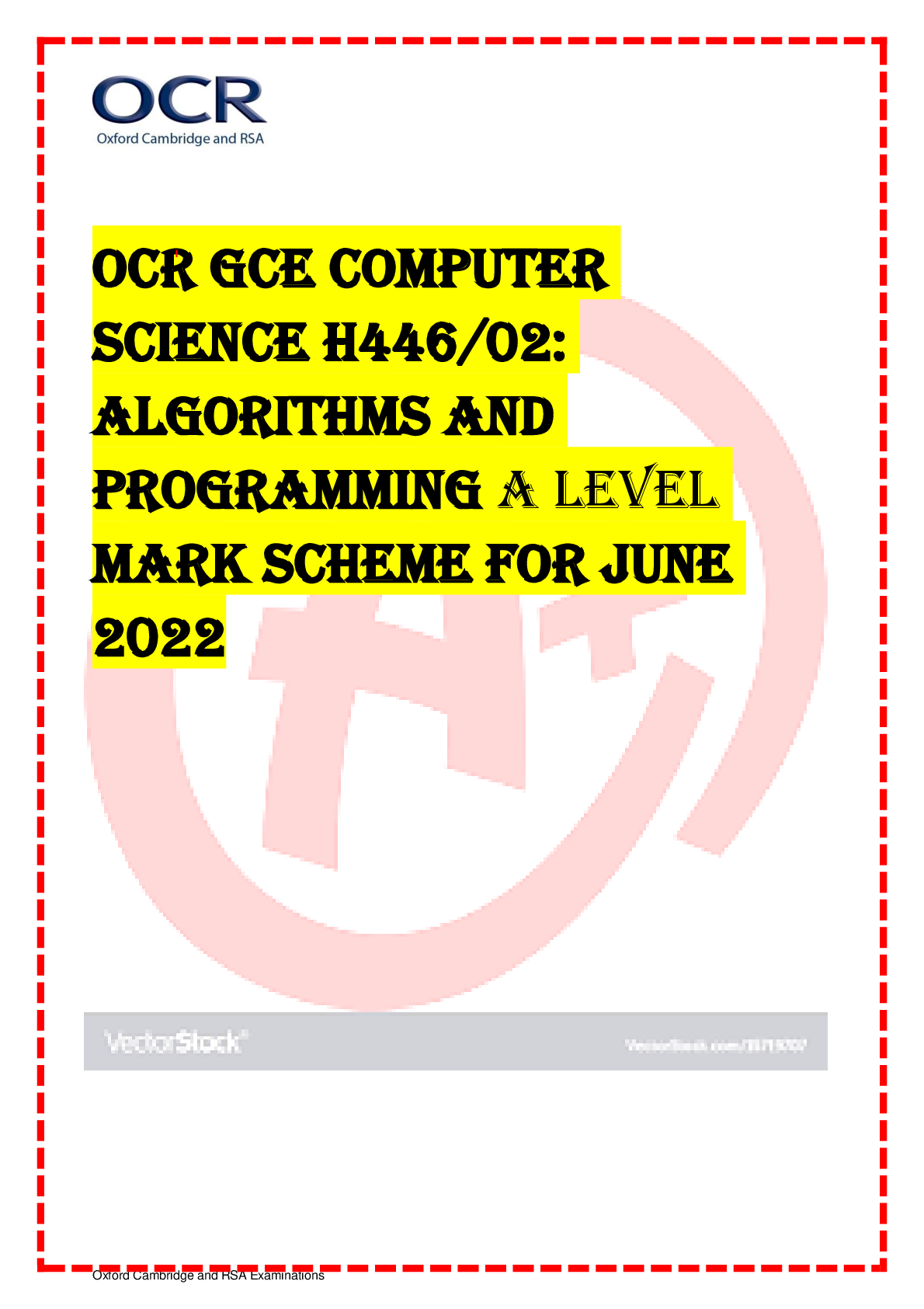History > AS Mark Scheme > GCE History A Y219/01: Russia 1894-1941 Advanced GCE Mark Scheme for November 2020 (All)
GCE History A Y219/01: Russia 1894-1941 Advanced GCE Mark Scheme for November 2020
Document Content and Description Below
Oxford Cambridge and RSA Examinations GCE History A Y219/01: Russia 1894-1941 Advanced GCE Mark Scheme for November 2020Oxford Cambridge and RSA Examinations OCR (Oxford Cambridge and RSA) is a ... leading UK awarding body, providing a wide range of qualifications to meet the needs of candidates of all ages and abilities. OCR qualifications include AS/A Levels, Diplomas, GCSEs, Cambridge Nationals, Cambridge Technicals, Functional Skills, Key Skills, Entry Level qualifications, NVQs and vocational qualifications in areas such as IT, business, languages, teaching/training, administration and secretarial skills. It is also responsible for developing new specifications to meet national requirements and the needs of students and teachers. OCR is a not-for-profit organisation; any surplus made is invested back into the establishment to help towards the development of qualifications and support, which keep pace with the changing needs of today’s society. This mark scheme is published as an aid to teachers and students, to indicate the requirements of the examination. It shows the basis on which marks were awarded by examiners. It does not indicate the details of the discussions which took place at an examiners’ meeting before marking commenced. All examiners are instructed that alternative correct answers and unexpected approaches in candidates’ scripts must be given marks that fairly reflect the relevant knowledge and skills demonstrated. Mark schemes should be read in conjunction with the published question papers and the report on the examination. © OCR 2020Unit Y219/01 Mark Scheme October 2020 Annotations Annotation Meaning Blank Page N/A Highlight Off-page comment Assertion Analysis Evaluation Explanation Factor Illustrates/Describes Irrelevant, a significant amount of material that does not answer the question Judgement Knowledge and understanding Provenance Simple comment Unclear ViewUnit Y219/01 Mark Scheme October 2020 Question Answer Mark Guidance 1 (a) Which of the following had a greater impact on Russian society in the 1930s? (i) Collectivisation (ii) The Five Year Plans Explain your answer with reference to both (i) and (ii). • In dealing with Collectivisation, answers might argue that it lead to far greater social control over the peasants, with over 90% of them in collectives by the end of the 1930s and monitored by methods like Machine Tractor Stations; • Answers might argue that collectivisation led to great misery in Russian society, with dekulakisation and the Holodomor leading to the deaths of millions; • Answers might argue that collectivisation led to great social transformation, with around 20 million peasants moving from the countryside into the cities; • Answers might refer to the pace of collectivisation having to be temporarily slowed in 1930; • Answers might consider the continued use of private plots by many peasants that shows the relative changes of collectivisation were more limited than first appears. • In dealing with The Five Year Plans, answers might argue that the enthusiasm and energy of the Five Year Plans – for example the mindset that ‘there were no fortresses a Bolshevik cannot storm’ – created greater 10 • No set answer is expected. • Judgement must be supported by relevant and accurate material. If not, mark as assertion. • Only credit material relevant to the impact on Russian society. • Answers may deal with each factor in turn, then compare them to reach a judgement, or may take a continually comparative approach. Either approach is acceptable. • Knowledge must not be credited in isolation, it should only be credited where it is used as the basis for analysis and evaluation, in line with the descriptions in the levels mark scheme.Unit Y219/01 Mark Scheme October 2020 commitment from many in Russian society; • Answers might argue that the Stakhanovite Movement created social mobility for some workers; • Answers might argue that greater control in the workplace, the introduction of workbooks and the harsh treatment given to ‘wreckers’ created fear among some people; • Answers might refer to the extent to which the shortages of consumer goods throughout the Five Year Plans meant that for many Russian workers living standards failed to improve and there was little real social change; • Answers might consider that the impact of the Five Year Plans was limited in the later 1930s by the activity of the NKVD during the Purges. 1 (b) * How far was Rasputin to blame for the downfall of Tsar Nicholas II? • In arguing Rasputin was to blame, answers might argue that Rasputin’s position of power by late 1915 caused the Tsar’s regime to lose credibility across Russian society; • Answers might argue that Rasputin’s scandalous behaviour offended the traditional values of many Russians and made the regime more unpopular; • Answers might argue that Rasputin’s influence over Nicholas and especially Alexandra caused instability in 20 • No set answer is expected. • At higher levels candidates will focus on “how far” but at Level 4 may simply list reasons. • At Level 5 and above there will be judgement as to the level of extent. • At higher levels candidates might establish criteria against which to measure relative blame.Unit Y219/01 Mark Scheme October 2020 government as seen by the ‘ministerial leapfrog’ during the First World War; • Answers might argue that Rasputin was a focus of Liberal discontent since they were denied a role in a ‘Ministry of National Confidence’ leading to Milyukov’s ‘Stupidity or Treason’ speech; • Answers might argue that Rasputin’s murder at the hands of a group of Russian nobles demonstrated that even the Tsar’s own peers had begun to tire of his rule and plotted against him. • In arguing other factors were to blame, answers might argue that since the main war effort was in the hands of Zemgor and the War Industry Committees by 1915 Rasputin’s influence, and so his role in the downfall of the Tsar, was limited; • Answers might argue that Nicholas himself was to blame for his own downfall, making the fateful decision to take personal responsibility of the Russian Army and becoming increasingly out of touch at Mogilev; • Answers might argue that Russia’s poor performance during the First World War and the failure of offensives such as Brusilov turned the army against the Tsar; • To be valid judgements, claims must be supported by relevant and accurate material. If not they are assertions. • Knowledge must not be credited in isolation, it should only be credited where it is used as the basis for analysis and evaluation, in line with descriptions in the levels mark scheme.Unit Y219/01 Mark Scheme October 2020 • Answers might argue that the economic hardship caused by the war turned the Russian people against the regime; • Answers might argue that the huge dislocation caused by the movement of millions of soldiers and refugees and the pressure it placed on cities resulted in the collapse of the regime; • Answers might argue that the events of February 1917 were the result of spontaneous and popular protests rather than focused around one specific issue.Unit Y219/01 Mark Scheme October 2020 Question Answer Mark Guidance 2 (a) Which of the following was more effective in allowing the Bolsheviks to maintain power after the revolution of November 1917? (i) The Lenin Decrees (ii) The dissolution of the Constituent Assembly Explain your answer with reference to both (i) and (ii). • In dealing with The Lenin Decrees, answers might argue that the Lenin Decrees were intended to appease the Russian people and so increase support for the Bolsheviks; • Answers might argue that given how unpopular the war had been in Russian, the Decree of Peace was vital in showing Bolshevik commitment to ending the war, and so increasing their support; • Answers might argue that the Decree on Workers’ Control was vital in ensuring that economic production continued and economic collapse was avoided; • Answers might refer to the Decree on Land being merely a recognition of what had already occurred in the countryside with widespread land seizures and the Bolsheviks were simply responding to events; • Answers might consider that many of the Lenin Decrees were only ever intended to be temporary and so were only an effective method in the short term; • In dealing with the dissolution of the Constituent Assembly, answers might argue that it allowed the Bolsheviks to remove the Socialist Revolutionaries from a position of power 10 No set answer is expected. • Judgement must be supported by relevant and accurate material. If not, mark as assertion. • Only credit material relevant to allowing the Bolsheviks to maintain power. • Answers may deal with each factor in turn, then compare them to reach a judgement, or may take a continually comparative approach. Either approach is acceptable. • Knowledge must not be credited in isolation, it should only be credited where it is used as the basis for analysis and evaluation, in line with the descriptions in the levels mark scheme.Unit Y219/01 Mark Scheme October 2020 which was crucially important given the SR’s strong performance in the November 1917 elections; • Answers might argue that it marked an end to any pretence at democracy by the Bolsheviks and allowed them to exercise single party control, banning rival parties in the following weeks; • Answers might argue that the violent manner in which the Bolsheviks dissolved the Assembly and handled protests about it showed an increased willingness to use force in order to maintain power, as seen by the ‘red terror’; • Answers might refer to unease and disagreements the dissolution caused within the Bolshevik movement itself – such as from Gorky – which showed internal divisions over the action; • Answers might consider how the dissolution would lead to the SRs forming the Komuch and eventually fighting against the Bolsheviks during the Civil War, increasing the opposition they faced. 2 (b) * ‘The improvement of agricultural production was the reason for voluntary and forced collectivisation in Russia after 1928.’ How far do you agree? • In arguing that the main reason was to improve agricultural production, answers might argue that the inefficient and traditional methods of the mir could only be overcome with a complete 20 • No set answer is expected. • At higher levels candidates will focus on “assess” but at Level 4 may simply list reasons.Unit Y219/01 Mark Scheme October 2020 overhaul of agriculture through collectivisation; • Answers might argue that in order to release more Soviet peasants to become part of the urban labour force agriculture needed to become more efficient through collectivisation; • Answers might argue that by 1928 the failures of NEP had become clear and collectivisation aimed to address this; • Answers might argue that peasants had responded to the lowering price of grain through the ‘scissors crisis’ by planting less and that greater state control through collectivisation would overcome this; • Answers might argue that food shortages and famines were a constant challenge facing Russian governments – most recently during the Civil War – and collectivisation was introduced to overcome this. • In arguing that there were other reasons, answers might argue that there were wider ideological and pragmatic reasons for voluntary and forced collectivisation in Russia after 1928; • Answers might argue that collectivisation had always been a long • At Level 5 and above there will be judgement as to the level of extent. • At higher levels candidates might establish separate criteria for voluntary and forced collectivisation. • To be valid judgements, claims must be supported by relevant and accurate material. If not they are assertions. • Knowledge must not be credited in isolation, it should only be credited where it is used as the basis for analysis and evaluation, in line with descriptions in the levels mark scheme.Unit Y219/01 Mark Scheme October 2020 term aim and that NEP had only ever been introduced as a temporary measure; • Answers might argue that collectivisation met ideological aims of greater state control; • Answers might argue that collectivisation was a method of identifying and dealing with the kulaks who Stalin believed were hoarding grain and were enemies of the state; • Answers might argue that Stalin used collectivisation to meet his own political aims, by abandoning NEP to undermine the right wing of the Party and to test the loyalty of his colleagues; • Answers might argue that collectivisation has to be seen in the wider context of the ‘Great Turn’ and the need for the USSR to modernise rapidly in order to combat a feared attack from the West.OCR (Oxford Cambridge and RSA Examinations) The Triangle Building Shaftesbury Road Cambridge CB2 8EA [Show More]
Last updated: 1 year ago
Preview 1 out of 12 pages
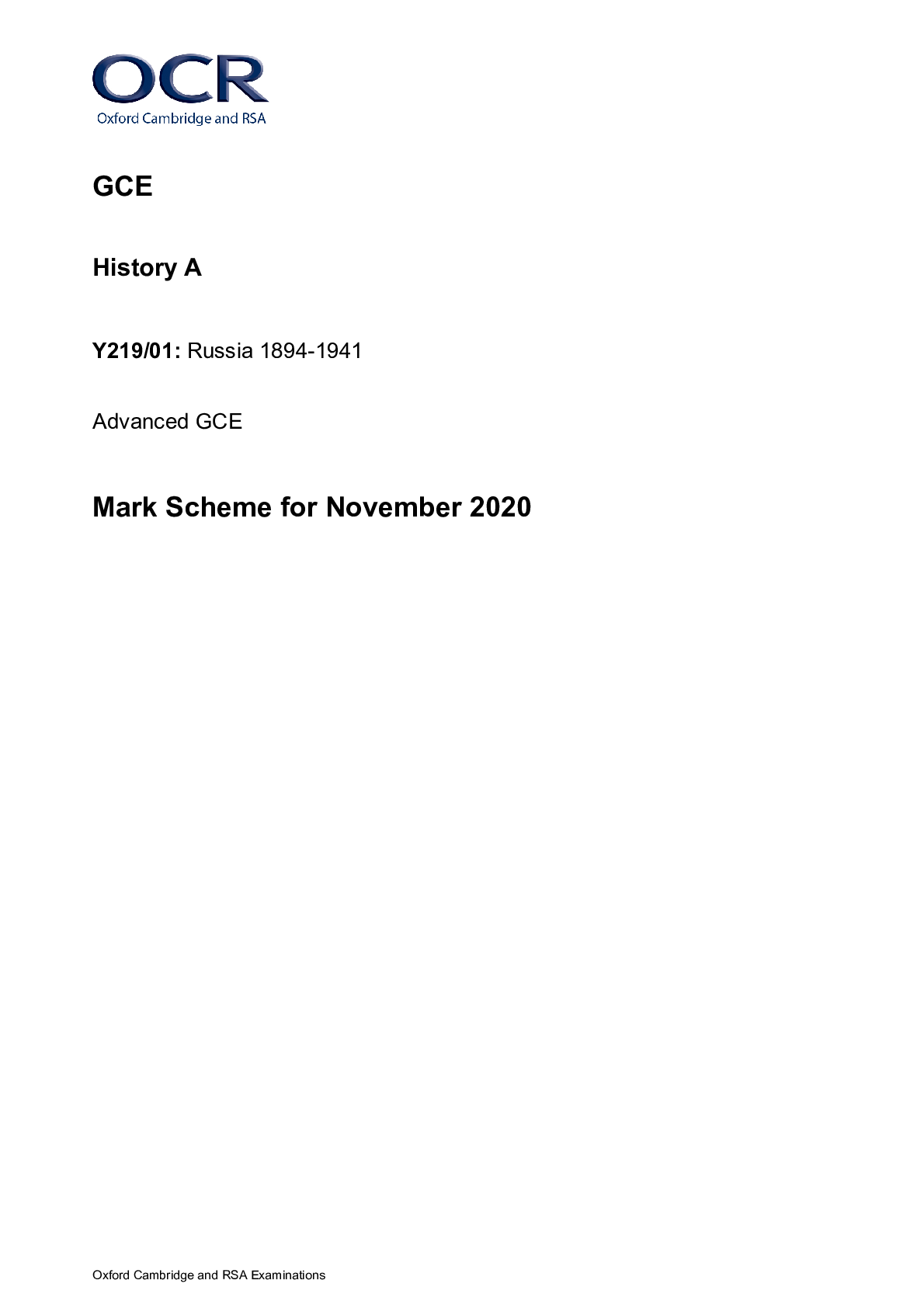
Reviews( 0 )
Document information
Connected school, study & course
About the document
Uploaded On
Oct 10, 2022
Number of pages
12
Written in
Additional information
This document has been written for:
Uploaded
Oct 10, 2022
Downloads
0
Views
37








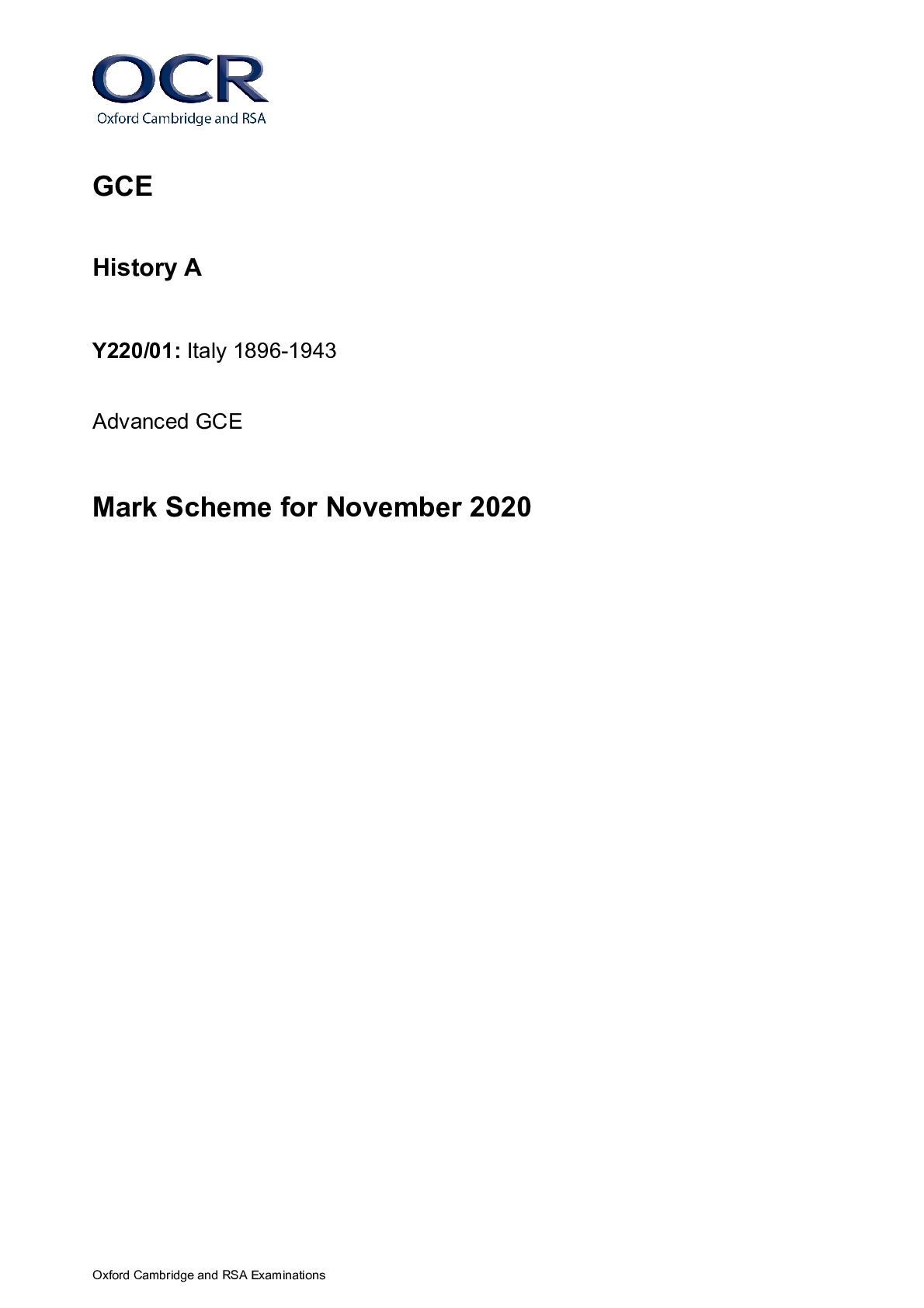

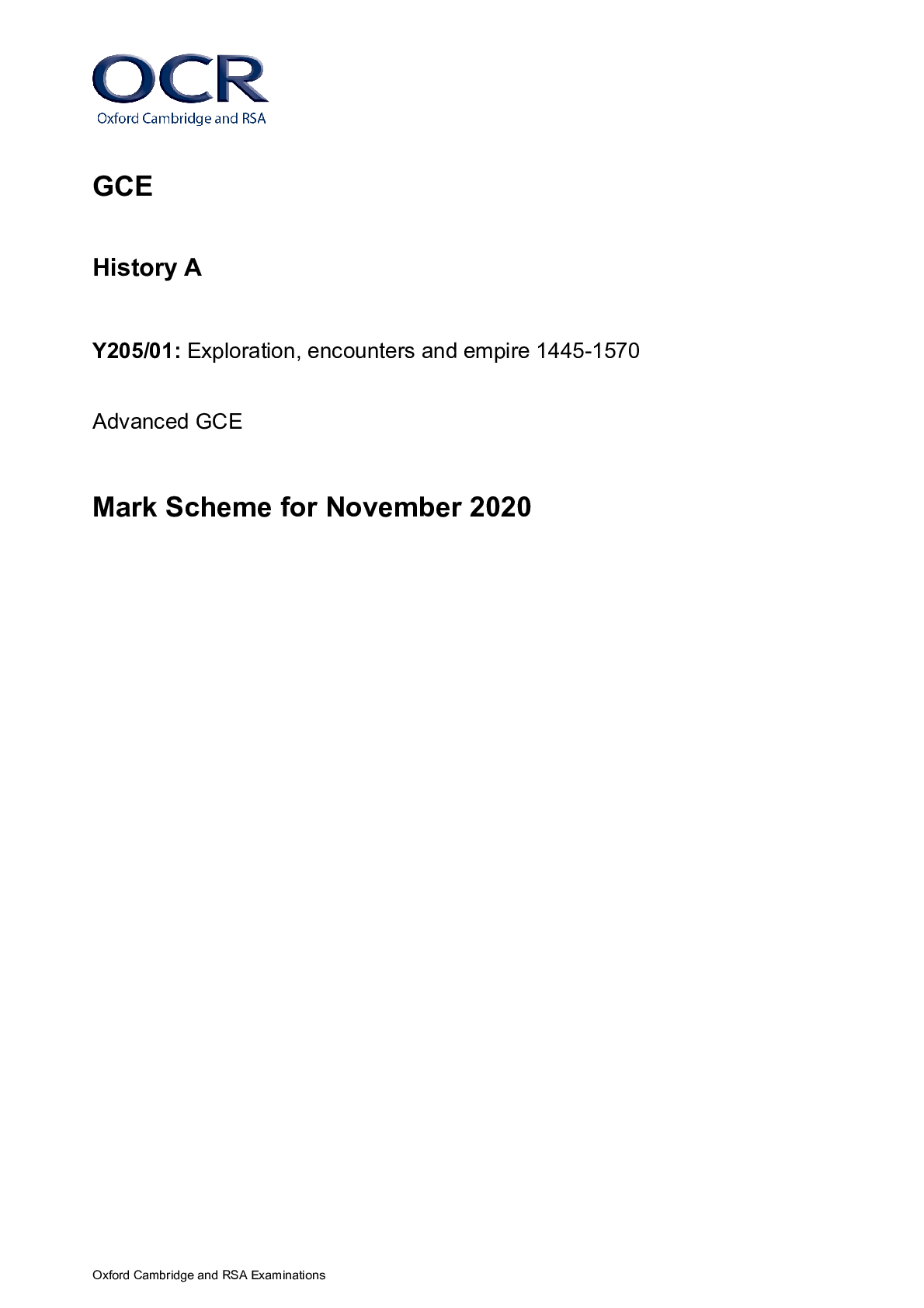
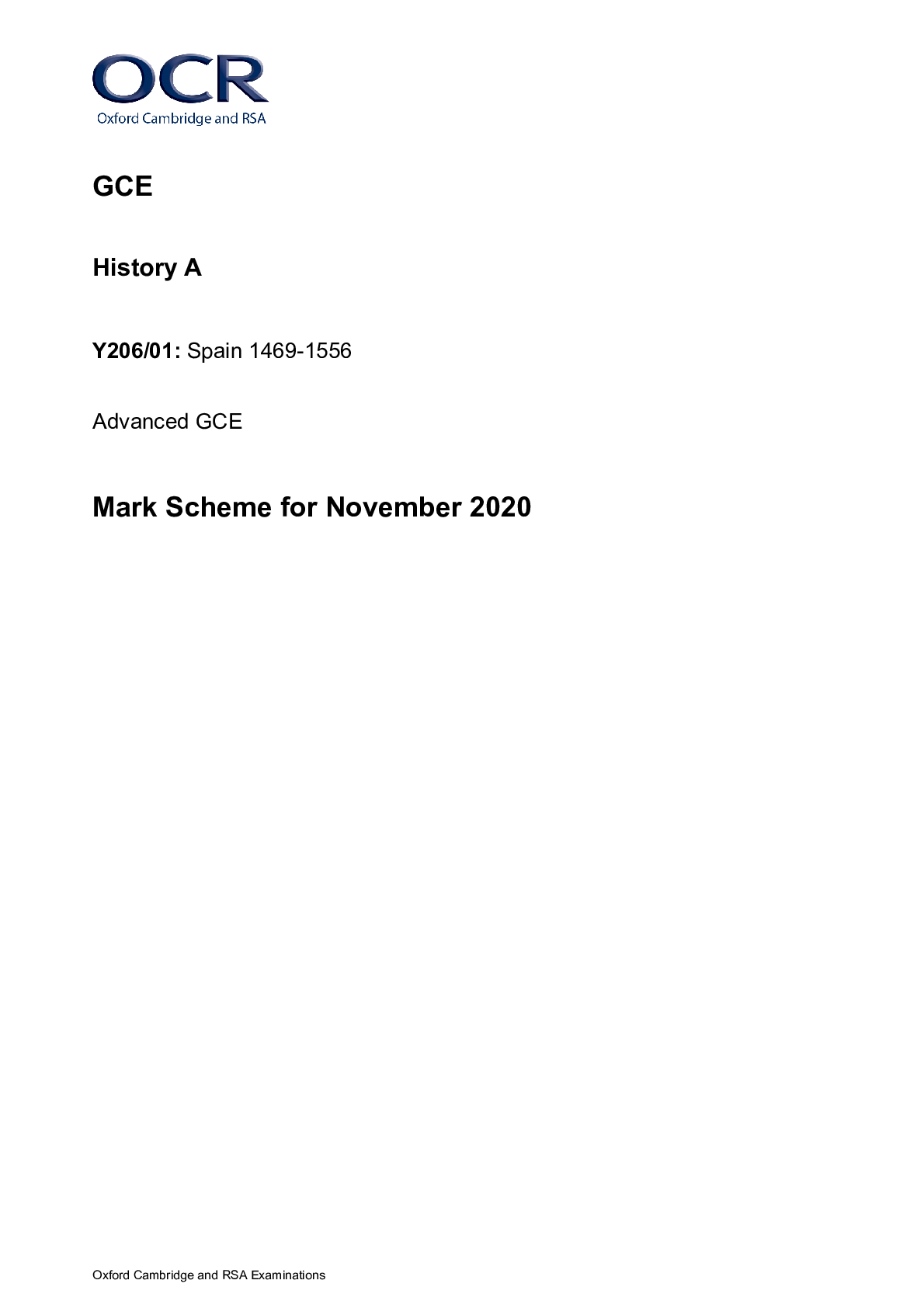
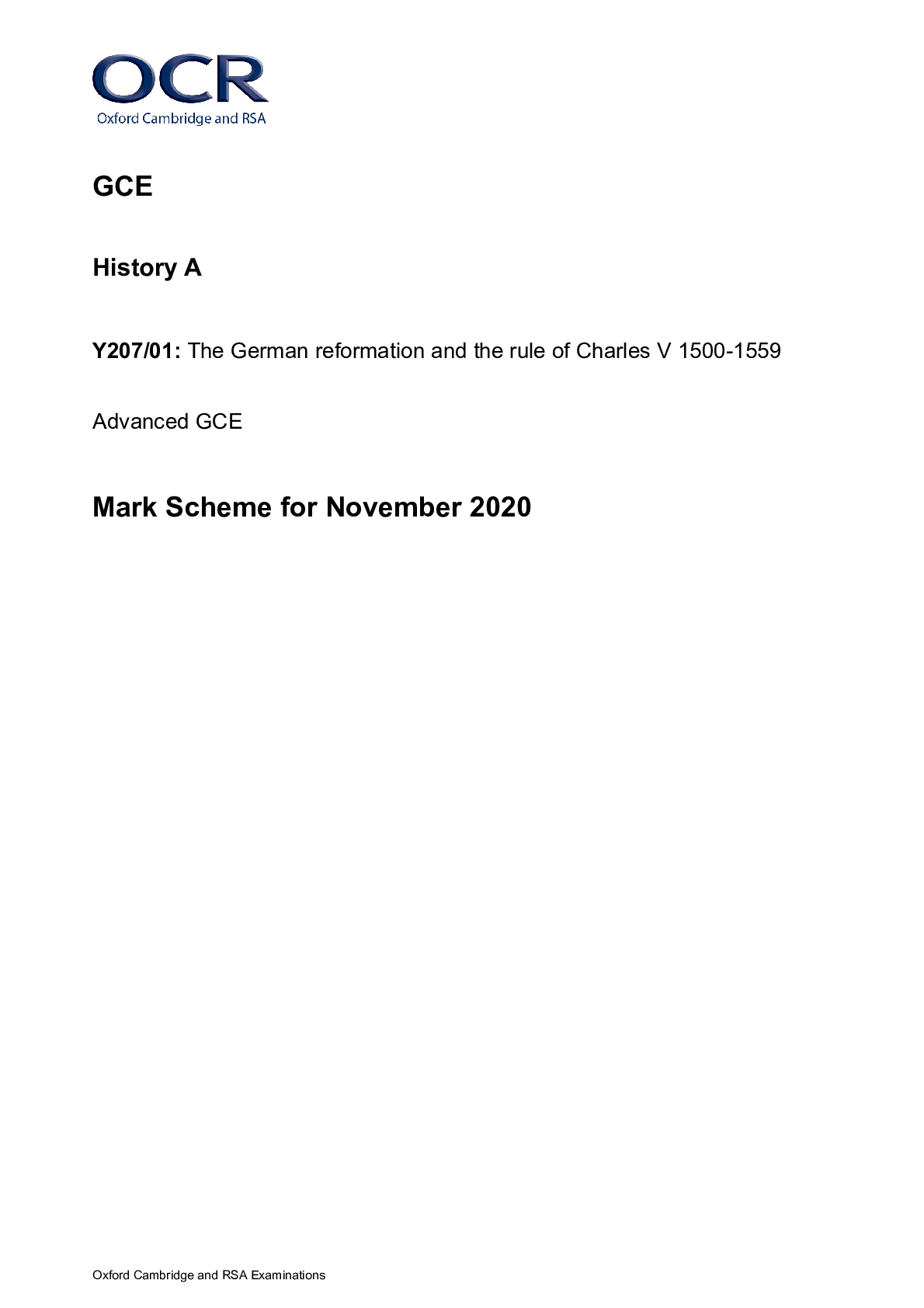
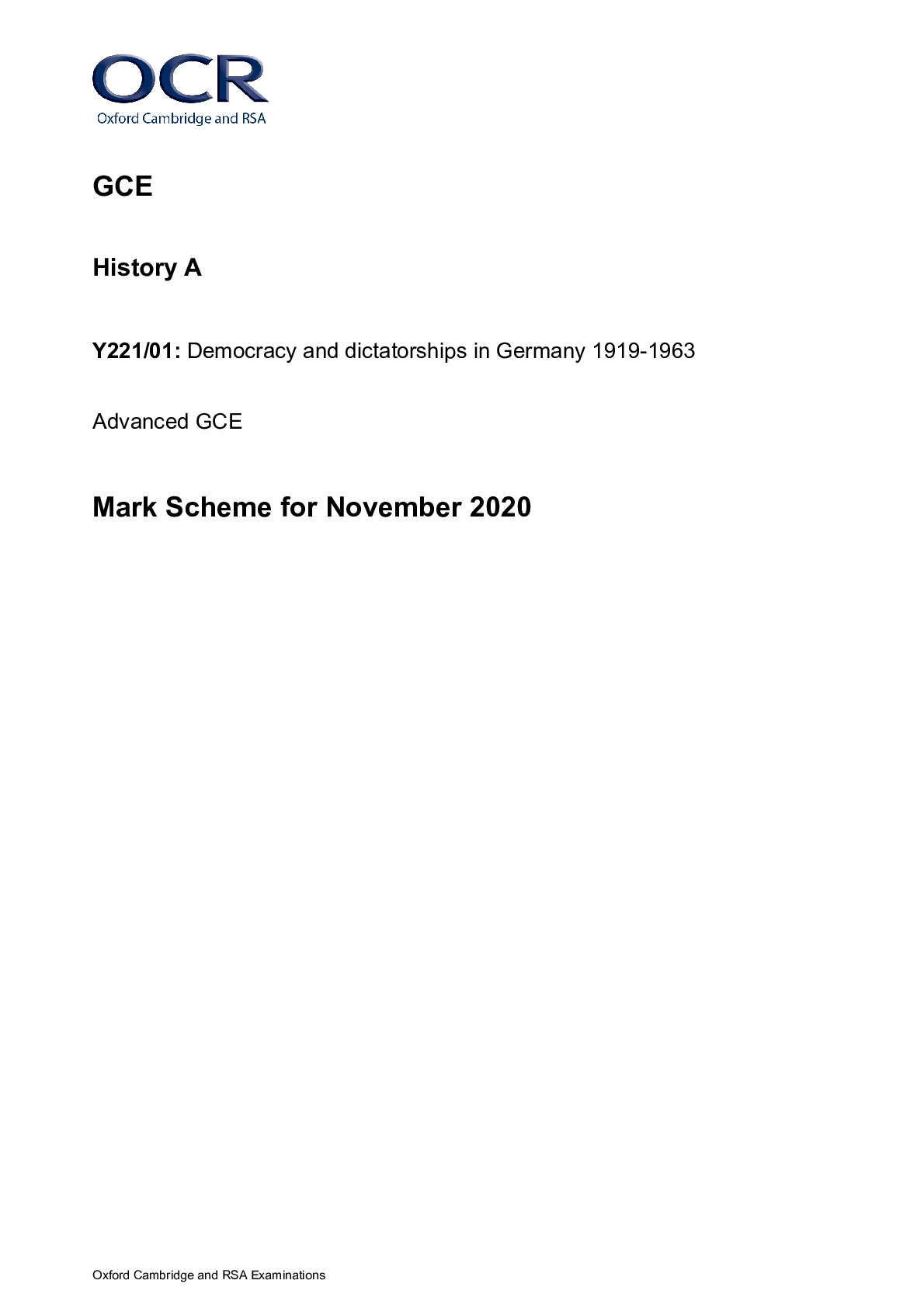

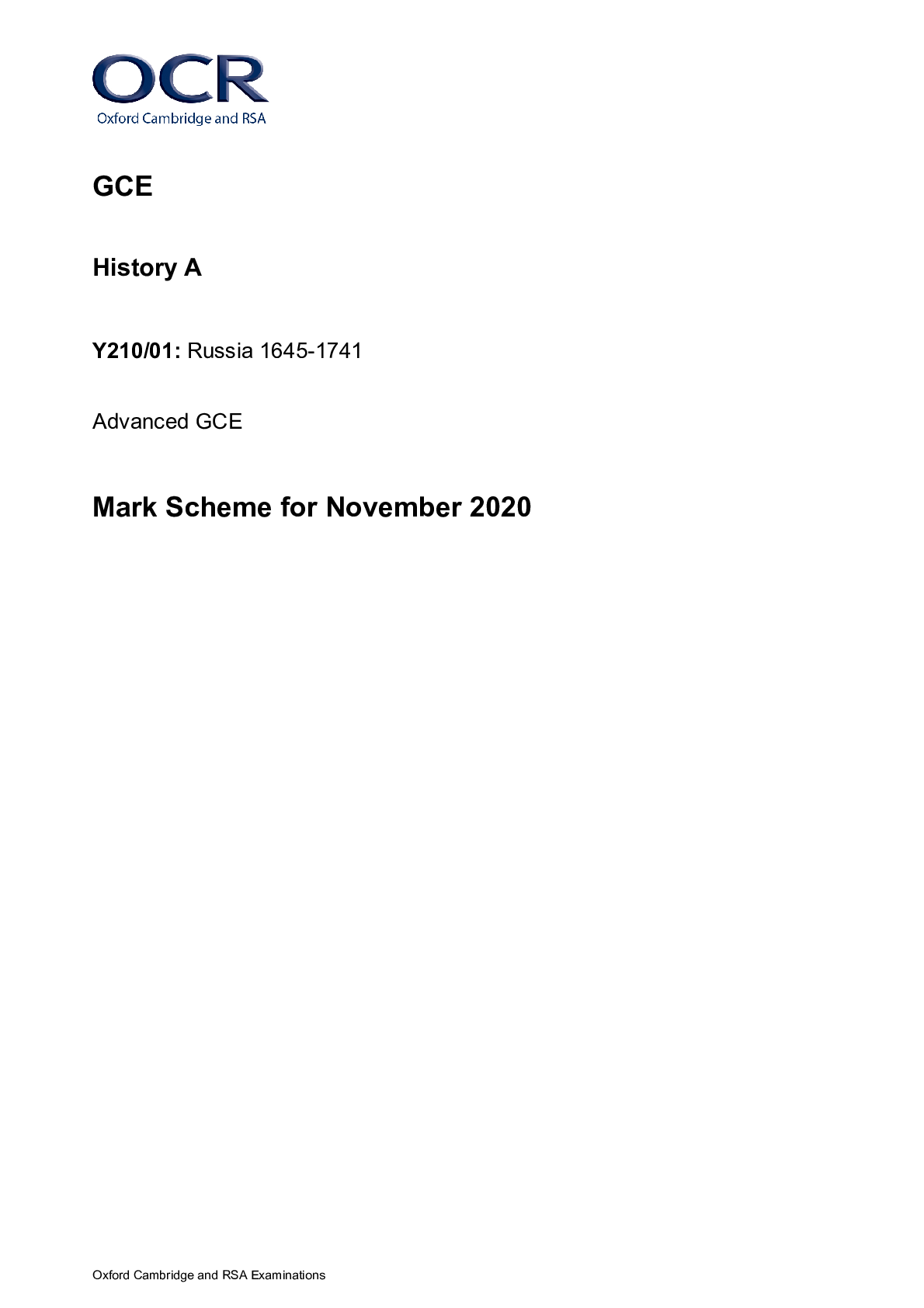


.png)



